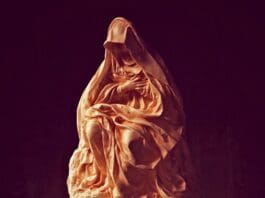
In 1239, the seven founders of the Servite Order established the sorrows of Mary, as she stood under the Cross, as the central devotion of their order. This took place five years after they settled on Monte Senario.
The feast began with a 1413 provincial synod in Cologne to atone for the actions of the iconoclast Hussites. Originally named “Commemoratio angustix et doloris B. Marix V”, its focus was solely on Mary’s sorrow during Christ’s Crucifixion and Death. Initially, this feast was predominantly celebrated in dioceses of North Germany, Scandinavia, and Scotland. Depending on the region, it was known by different titles and observed on various dates, mainly during Eastertide or after Pentecost.
Several rhythmical offices, sequences, and hymns from the end of the 15th century suggest that in many dioceses, the feast began to encompass either:
1. Five sorrows, from Christ’s imprisonment to burial.
2. Seven sorrows, spanning Mary’s entire life.
By the late 16th century, the feast had expanded to parts of southern Europe. Different communities observed it on various dates, with varying titles. Notably, in 1727, Benedict XIII extended the feast to the entire Latin Church under the title “Septem dolorum B.M.V.”. However, its essence remained rooted in Mary’s Compassion at the Cross. The renowned “Stabat Mater” by Giacopone da Todi (1306) became integral to its Mass and Office.
A second, distinct feast emerged in 1668, specifically for the Servites, observed on June 9 and September 15. This feast celebrated the seven sorrows of Mary:
1. The prophecy of Simeon.
2. The flight into Egypt.
3. The loss of the Holy Child in Jerusalem.
4. Meeting Jesus en route to Calvary.
5. Standing at the foot of the Cross.
6. The removal of Jesus from the Cross.
7. The burial of Christ.
The feast gained traction, spreading to Spain in 1735 and Tuscany in 1807. Pius VII further extended it to the Latin Church in 1814.
Certain regions, like Goa in India and Braga in Portugal, observe a feast titled “B.M.V. de pietate” on the third Sunday of October. It pays homage to the sorrowful mother with a rich medieval office. Spanish-speaking countries have a unique devotion named “N.S. de la Soledad”, reflecting on Mary’s solitude on Holy Saturday. This particular tradition traces its roots back to Queen Juana, who mourned the untimely death of her spouse, Philip I, King of Spain, in 1506.
Photo credit: 80's Child / Shutterstock.com
The post Memorial of Our Lady of Sorrows appeared first on uCatholic.
Daily Reading
Thursday of the Second Week in Ordinary Time
Reading 1 Hebrews 7:25—8:6 Jesus is always able to save those who approach God through him, since he lives forever to make intercession for them. It was fitting that we…
Daily Meditation
Finding Solace in Jesus
Click here for daily readings “He had cured many, and, as a result, those who had diseases were pressing upon him to touch him” (Mk 3:10). This scene opens with…




